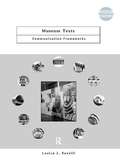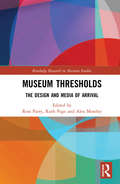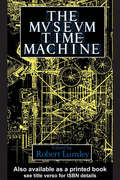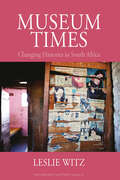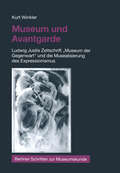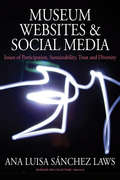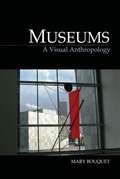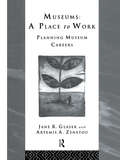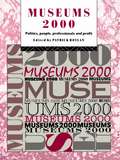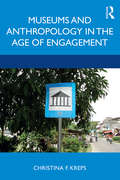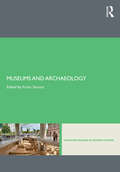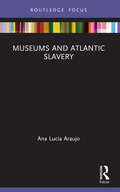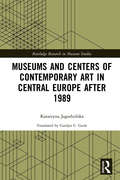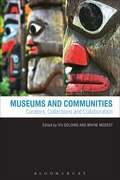- Table View
- List View
Museum Texts: Comunication Frameworks (Museum Meanings)
by Louise RavelliAnswering key questions in the study of how museums communicate, Louise Ravelli provides a set of frameworks to investigate the complexities of communication in museums: * What is an appropriate level of complexity for a written label?* Why do some choice in language make a more direct relation to visitors?* Is there a correct way of presenting a particular view of content?* How do design practices contribute to the overall meanings being made? The frameworks enhance the way we critically analyze and understand museums text, both in the sense of conventional – written texts in museums – and in an expanded sense of the museum as a whole operating as a communicative text. Using a wide range of examples Ravelli argues that communication contributes fundamentally to what a museum is, who it relates to and what it stands for. Not only museum studies and communications studies students, but also professionals in the field will find Museum Texts an indispensable guide on communication frameworks.
Museum Texts: Comunication Frameworks (Museum Meanings)
by Louise RavelliAnswering key questions in the study of how museums communicate, Louise Ravelli provides a set of frameworks to investigate the complexities of communication in museums: * What is an appropriate level of complexity for a written label?* Why do some choice in language make a more direct relation to visitors?* Is there a correct way of presenting a particular view of content?* How do design practices contribute to the overall meanings being made? The frameworks enhance the way we critically analyze and understand museums text, both in the sense of conventional – written texts in museums – and in an expanded sense of the museum as a whole operating as a communicative text. Using a wide range of examples Ravelli argues that communication contributes fundamentally to what a museum is, who it relates to and what it stands for. Not only museum studies and communications studies students, but also professionals in the field will find Museum Texts an indispensable guide on communication frameworks.
Museum Thresholds: The Design and Media of Arrival (Routledge Research in Museum Studies)
by Ross Parry Ruth Page Alex MoseleyMuseum Thresholds is a progressive, interdisciplinary volume and the first to explore the importance and potential of entrance spaces for visitor experience. Bringing together an international collection of writers from different disciplines, the chapters in this volume offer different theoretical perspectives on the nature of engagement, interaction and immersion in threshold spaces, and the factors which enable and inhibit those immersive possibilities. Organised into themed sections, the book explores museum thresholds from three different perspectives. Considering them first as a problem space, the contributors then go on to explore thresholds through different media and, finally, draw upon other subjects and professions, including performance, gaming, retail and discourse studies, in order to examine them from an entirely new perspective. Drawing upon examples that span Asia, North America and Europe, the authors set the entrance space in its historical, social and architectural contexts. Together, the essays show how the challenges posed by the threshold can be rethought and reimagined from a variety of perspectives, each of which have much to bring to future thinking and design. Combining both theory and practice, Museum Thresholds should be essential reading for academics, researchers and postgraduate students working in museum studies, digital heritage, architecture, design studies, retail studies and media studies. It will also be of great interest to museum practitioners working in a wide variety of institutions around the globe.
Museum Thresholds: The Design and Media of Arrival (Routledge Research in Museum Studies)
Museum Thresholds is a progressive, interdisciplinary volume and the first to explore the importance and potential of entrance spaces for visitor experience. Bringing together an international collection of writers from different disciplines, the chapters in this volume offer different theoretical perspectives on the nature of engagement, interaction and immersion in threshold spaces, and the factors which enable and inhibit those immersive possibilities. Organised into themed sections, the book explores museum thresholds from three different perspectives. Considering them first as a problem space, the contributors then go on to explore thresholds through different media and, finally, draw upon other subjects and professions, including performance, gaming, retail and discourse studies, in order to examine them from an entirely new perspective. Drawing upon examples that span Asia, North America and Europe, the authors set the entrance space in its historical, social and architectural contexts. Together, the essays show how the challenges posed by the threshold can be rethought and reimagined from a variety of perspectives, each of which have much to bring to future thinking and design. Combining both theory and practice, Museum Thresholds should be essential reading for academics, researchers and postgraduate students working in museum studies, digital heritage, architecture, design studies, retail studies and media studies. It will also be of great interest to museum practitioners working in a wide variety of institutions around the globe.
The Museum Time Machine: Putting Cultures on Display (Comedia)
by Robert LumleyA provocative contribution to the current debate on museums, this collection of essays contains contributions from France, Britain, Australia, the USA and Canada.
The Museum Time Machine: Putting Cultures on Display (Comedia)
by Robert LumleyA provocative contribution to the current debate on museums, this collection of essays contains contributions from France, Britain, Australia, the USA and Canada.
Museum Times: Changing Histories in South Africa (Museums and Collections #16)
by Leslie WitzMuseums flourished in post-apartheid South Africa. In older museums, there were renovations on the go, and at least fifty new museums opened. Most sought to depict violence and suffering under apartheid and the growth of resistance. These unlikely journeys are tracked as museums became a primary setting for contesting histories. From the renowned Robben Island Museum to the almost unknown Lwandle Migrant Labour Museum, the author demonstrates how an institution concerned with the conservation of the past is simultaneously a site for changing history.
Museum und Avantgarde: Ludwig Justis Zeitschrift „Museum der Gegenwart“ und die Musealisierung des Expressionismus (Berliner Schriften zur Museumskunde #17)
by Kurt WinklerAm Beispiel der Zeitschrift "Museum der Gegenwart" (1930-1933) schildert der Band den Kampf um die öffentliche Anerkennung des Expressionismus und die Genese des Museums zeitgenössischer Kunst. Seit 1930 gab Ludwig Justi, der Direktor der Berliner Nationalgalerie, die Zeitschrift "Museum der Gegenwart" heraus. Das Impressum liest sich wie ein Who is who des Museumswesens: Justi war es gelungen, alle Kollegen für die Mitarbeit zu begeistern, die der zeitgenössischen Kunst besonderes Augenmerk widmeten. Die Kooperation mit Alfred H. Barr, dem Gründungsdirektor des New Yorker Museum of Modern Art, demonstrierte den Anspruch der neuen Kunstzeitschrift, der Avantgarde im Museum über alle Grenzen hinweg Geltung zu verschaffen. Die 1933 abgebrochene Geschichte der Zeitschrift spiegelt den Kampf der deutschen Museen für die Anerkennung des Expressionismus. Die Analyse wirft aber auch Fragen auf, die bis heute das Museum zeitgenössischer Kunst prägen: Wie verändert die Integration der Avantgarde die bürgerliche Institution Museum? Und wie wirkt der Prozess der Musealisierung zurück auf Verständnis und Selbstverständnis avantgardistischer Kunst?
Museum Websites and Social Media: Issues of Participation, Sustainability, Trust and Diversity (Museums and Collections #8)
by Ana Sánchez LawsOnline activities present a unique challenge for museums as they harness the potential of digital technology for sustainable development, trust building, and representations of diversity. This volume offers a holistic picture of museum online activities that can serve as a starting point for cross-disciplinary discussion. It is a resource for museum staff, students, designers, and researchers working at the intersection of cultural institutions and digital technologies. The aim is to provide insight into the issues behind designing and implementing web pages and social media to serve the broadest range of museum stakeholders.
Museums: A Visual Anthropology (Key Texts in the Anthropology of Visual and Material Culture)
by Mary BouquetMuseums: A Visual Anthropology provides a clear and concise summary of the key ideas, debates and texts of the most important approaches to the study of museums from around the world. The book examines ways to address the social relations of museums, embedded in their sites, collections, and exhibitions, as an integral part of the visual and material culture they comprise. Cross-disciplinary in scope, Museums uses ideas and approaches both from within and outside of anthropology to further students' knowledge of and interest in museums. Including selected, globally based case studies to highlight and exemplify important issues, the book also contains suggested Further Reading for each chapter, for students to expand their learning independently. Exploring fundamental methods and approaches to engage this constantly evolving time machine, Museums will be essential reading for students of anthropology and museum studies.
Museums: A Visual Anthropology (Key Texts in the Anthropology of Visual and Material Culture #23)
by Mary BouquetMuseums: A Visual Anthropology provides a clear and concise summary of the key ideas, debates and texts of the most important approaches to the study of museums from around the world. The book examines ways to address the social relations of museums, embedded in their sites, collections, and exhibitions, as an integral part of the visual and material culture they comprise. Cross-disciplinary in scope, Museums uses ideas and approaches both from within and outside of anthropology to further students' knowledge of and interest in museums. Including selected, globally based case studies to highlight and exemplify important issues, the book also contains suggested Further Reading for each chapter, for students to expand their learning independently. Exploring fundamental methods and approaches to engage this constantly evolving time machine, Museums will be essential reading for students of anthropology and museum studies.
Museums: Planning Museum Careers
by Jane R. Glaser Artemis A. ZenetouSurveying over thirty different positions in the museum profession, this is the essential guide for anyone considering entering the field, or a career change within it. From exhibition designer to shop manager, this comprehensive survey views the latest trends in museum work and the broad-ranging technological advances that have been made. For any professional in the field, this is a crucially useful book for how to prepare, look for and find jobs in the museum profession.
Museums: Planning Museum Careers
by Jane R. Glaser Artemis A. ZenetouSurveying over thirty different positions in the museum profession, this is the essential guide for anyone considering entering the field, or a career change within it. From exhibition designer to shop manager, this comprehensive survey views the latest trends in museum work and the broad-ranging technological advances that have been made. For any professional in the field, this is a crucially useful book for how to prepare, look for and find jobs in the museum profession.
Museums 2000: Politics, People, Professionals and Profit (Heritage: Care-Preservation-Management)
by Patrick Boylan International Committee International Committee of MuseumsMuseum and art galleries have never been so much in the news as they have been over the past decade. Yet public focus at both professional and non-specialist levels has been remarkable for what has been accidentally or deliberatley left out of recent debates. Moving beyond the narrow issues of professional practice, Museums 2000 probes the political, economic and cultural realities which affect museums today. Because the contributos are drawn from the museum profession and the wider political, academic and business community worldwide, the book is truly international, reflecting the issues which affect all museums.
Museums 2000: Politics, People, Professionals and Profit (Heritage: Care-Preservation-Management)
by Patrick J. BoylanMuseum and art galleries have never been so much in the news as they have been over the past decade. Yet public focus at both professional and non-specialist levels has been remarkable for what has been accidentally or deliberatley left out of recent debates. Moving beyond the narrow issues of professional practice, Museums 2000 probes the political, economic and cultural realities which affect museums today. Because the contributos are drawn from the museum profession and the wider political, academic and business community worldwide, the book is truly international, reflecting the issues which affect all museums.
Museums and Anthropology in the Age of Engagement
by Christina KrepsMuseums and Anthropology in the Age of Engagement considers changes that have been taking place in museum anthropology as it has been responding to pressures to be more socially relevant, useful, and accountable to diverse communities. Based on the author’s own research and applied work over the past 30 years, the book gives examples of the wide-ranging work being carried out today in museum anthropology as both an academic, scholarly field and variety of applied, public anthropology. While it examines major trends that characterize our current "age of engagement," the book also critically examines the public role of museums and anthropology in colonial and postcolonial contexts, namely in the US, the Netherlands, and Indonesia. Throughout the book, Kreps questions what purposes and interests museums and anthropology serve in these different times and places. Museums and Anthropology in the Age of Engagement is a valuable resource for readers interested in an historical and comparative study of museums and anthropology, and the forms engagement has taken. It should be especially useful to students and instructors looking for a text that provides in one volume a history of museum anthropology and methods for doing critical, reflexive museum ethnography and collaborative work.
Museums and Anthropology in the Age of Engagement
by Christina KrepsMuseums and Anthropology in the Age of Engagement considers changes that have been taking place in museum anthropology as it has been responding to pressures to be more socially relevant, useful, and accountable to diverse communities. Based on the author’s own research and applied work over the past 30 years, the book gives examples of the wide-ranging work being carried out today in museum anthropology as both an academic, scholarly field and variety of applied, public anthropology. While it examines major trends that characterize our current "age of engagement," the book also critically examines the public role of museums and anthropology in colonial and postcolonial contexts, namely in the US, the Netherlands, and Indonesia. Throughout the book, Kreps questions what purposes and interests museums and anthropology serve in these different times and places. Museums and Anthropology in the Age of Engagement is a valuable resource for readers interested in an historical and comparative study of museums and anthropology, and the forms engagement has taken. It should be especially useful to students and instructors looking for a text that provides in one volume a history of museum anthropology and methods for doing critical, reflexive museum ethnography and collaborative work.
Museums and Archaeology (Leicester Readers in Museum Studies)
by Robin SkeatesMuseums and Archaeology brings together a wide, but carefully chosen, selection of literature from around the world that connects museums and archaeology. Part of the successful Leicester Readers in Museum Studies series, it provides a combination of issue- and practice-based perspectives. As such, it is a volume not only for students and researchers from a range of disciplines interested in museum, gallery and heritage studies, including public archaeology and cultural resource management (CRM), but also the wide range of professionals and volunteers in the museum and heritage sector who work with archaeological collections. The volume’s balance of theory and practice and its thematic and geographical breadth is explored and explained in an extended introduction, which situates the readings in the context of the extensive literature on museum archaeology, highlighting the many tensions that exist between idealistic ‘principles’ and real-life ‘practice’ and the debates that surround these. In addition to this, section introductions and the seminal pieces themselves provide a comprehensive and contextualised resource on the interplay of museums and archaeology. .
Museums and Archaeology (Leicester Readers in Museum Studies)
by Robin SkeatesMuseums and Archaeology brings together a wide, but carefully chosen, selection of literature from around the world that connects museums and archaeology. Part of the successful Leicester Readers in Museum Studies series, it provides a combination of issue- and practice-based perspectives. As such, it is a volume not only for students and researchers from a range of disciplines interested in museum, gallery and heritage studies, including public archaeology and cultural resource management (CRM), but also the wide range of professionals and volunteers in the museum and heritage sector who work with archaeological collections. The volume’s balance of theory and practice and its thematic and geographical breadth is explored and explained in an extended introduction, which situates the readings in the context of the extensive literature on museum archaeology, highlighting the many tensions that exist between idealistic ‘principles’ and real-life ‘practice’ and the debates that surround these. In addition to this, section introductions and the seminal pieces themselves provide a comprehensive and contextualised resource on the interplay of museums and archaeology. .
Museums and Atlantic Slavery (Museums in Focus)
by Ana Lucia AraujoMuseums and Atlantic Slavery explores how slavery, the Atlantic slave trade, and enslaved people are represented through words, visual images, artifacts, and audiovisual materials in museums in Europe and the Americas. Divided into four chapters, the book addresses four recurrent themes: wealth and luxury; victimhood and victimization; resistance and rebellion; and resilience and achievement. Considering the roles of various social actors who have contributed to the introduction of slavery in the museum in the last thirty years, the analysis draws on selected exhibitions, and institutions entirely dedicated to slavery, as well as national, community, plantation, and house museums in the United States, England, France, and Brazil. Engaging with literature from a range of disciplines, including history, anthropology, sociology, art history, tourism and museum studies, Araujo provides an overview of a topic that has not yet been adequately discussed and analysed within the museum studies field. Museums and Atlantic Slavery encourages scholars, students, and museum professionals to critically engage with representations of slavery in museums. The book will help readers to recognize how depictions of human bondage in museums and exhibitions often fail to challenge racism and white supremacy inherited from the period of slavery.
Museums and Atlantic Slavery (Museums in Focus)
by Ana Lucia AraujoMuseums and Atlantic Slavery explores how slavery, the Atlantic slave trade, and enslaved people are represented through words, visual images, artifacts, and audiovisual materials in museums in Europe and the Americas. Divided into four chapters, the book addresses four recurrent themes: wealth and luxury; victimhood and victimization; resistance and rebellion; and resilience and achievement. Considering the roles of various social actors who have contributed to the introduction of slavery in the museum in the last thirty years, the analysis draws on selected exhibitions, and institutions entirely dedicated to slavery, as well as national, community, plantation, and house museums in the United States, England, France, and Brazil. Engaging with literature from a range of disciplines, including history, anthropology, sociology, art history, tourism and museum studies, Araujo provides an overview of a topic that has not yet been adequately discussed and analysed within the museum studies field. Museums and Atlantic Slavery encourages scholars, students, and museum professionals to critically engage with representations of slavery in museums. The book will help readers to recognize how depictions of human bondage in museums and exhibitions often fail to challenge racism and white supremacy inherited from the period of slavery.
Museums and Centers of Contemporary Art in Central Europe after 1989 (Routledge Research in Museum Studies)
by Katarzyna JagodzińskaMuseums and Centers of Contemporary Art in Central Europe is a comprehensive study of the ecosystem of art museums and centers in the Czech Republic, Hungary, Poland and Slovakia. Focusing on institutions founded after 1989, the book analyses a thirty-year boom in art exhibition space in these regions, as well as a range of socio-political influences and curatorial debates that had a significant impact upon their development. Tracing the inspiration for the increase in art institutions and the models upon which these new spaces were based, Jagodzińska offers a unique insight into the history of museums in Central Europe. Providing analysis of a range of issues, including private and public patronage, architecture, and changing visions of national museums of art, the book situates these newly-founded institutions within their historical, political and museological contexts. Considering whether - and in what ways - they can be said to have a shared regional identity that is distinct from institutions elsewhere, this valuable contribution paints a picture of the region in its entirety from the perspective of new institutions of art. Offering the first comprehensive study on the topic, Museums and Centers of Contemporary Art in Central Europe should be of great interest to academics, researchers and postgraduate students engaged in the study of museums, art, history and architecture.
Museums and Centers of Contemporary Art in Central Europe after 1989 (Routledge Research in Museum Studies)
by Katarzyna JagodzińskaMuseums and Centers of Contemporary Art in Central Europe is a comprehensive study of the ecosystem of art museums and centers in the Czech Republic, Hungary, Poland and Slovakia. Focusing on institutions founded after 1989, the book analyses a thirty-year boom in art exhibition space in these regions, as well as a range of socio-political influences and curatorial debates that had a significant impact upon their development. Tracing the inspiration for the increase in art institutions and the models upon which these new spaces were based, Jagodzińska offers a unique insight into the history of museums in Central Europe. Providing analysis of a range of issues, including private and public patronage, architecture, and changing visions of national museums of art, the book situates these newly-founded institutions within their historical, political and museological contexts. Considering whether - and in what ways - they can be said to have a shared regional identity that is distinct from institutions elsewhere, this valuable contribution paints a picture of the region in its entirety from the perspective of new institutions of art. Offering the first comprehensive study on the topic, Museums and Centers of Contemporary Art in Central Europe should be of great interest to academics, researchers and postgraduate students engaged in the study of museums, art, history and architecture.
Museums and Communities: Curators, Collections and Collaboration
by Viv Golding Wayne ModestThis edited volume critically engages with contemporary scholarship on museums and their engagement with the communities they purport to serve and represent. Foregrounding new curatorial strategies, it addresses a significant gap in the available literature, exploring some of the complex issues arising from recent approaches to collaboration between museums and their communities.The book unpacks taken-for-granted notions such as scholarship, community, participation and collaboration, which can gloss over the complexity of identities and lead to tokenistic claims of inclusion by museums. Over sixteen chapters, well-respected authors from the US, Australia and Europe offer a timely critique to address what happens when museums put community-minded principles into practice, challenging readers to move beyond shallow notions of political correctness that ignore vital difference in this contested field. Contributors address a wide range of key issues, asking pertinent questions such as how museums negotiate the complexities of integrating collaboration when the target community is a living, fluid, changeable mass of people with their own agendas and agency. When is engagement real as opposed to symbolic, who benefits from and who drives initiatives? What particular challenges and benefits do artist collaborations bring? Recognising the multiple perspectives of community participants is one thing, but how can museums incorporate this successfully into exhibition practice?Students of museum and cultural studies, practitioners and everyone who cares about museums around the world will find this volume essential reading.
Museums and Communities: Curators, Collections and Collaboration
by Viv Golding Wayne ModestThis edited volume critically engages with contemporary scholarship on museums and their engagement with the communities they purport to serve and represent. Foregrounding new curatorial strategies, it addresses a significant gap in the available literature, exploring some of the complex issues arising from recent approaches to collaboration between museums and their communities.The book unpacks taken-for-granted notions such as scholarship, community, participation and collaboration, which can gloss over the complexity of identities and lead to tokenistic claims of inclusion by museums. Over sixteen chapters, well-respected authors from the US, Australia and Europe offer a timely critique to address what happens when museums put community-minded principles into practice, challenging readers to move beyond shallow notions of political correctness that ignore vital difference in this contested field. Contributors address a wide range of key issues, asking pertinent questions such as how museums negotiate the complexities of integrating collaboration when the target community is a living, fluid, changeable mass of people with their own agendas and agency. When is engagement real as opposed to symbolic, who benefits from and who drives initiatives? What particular challenges and benefits do artist collaborations bring? Recognising the multiple perspectives of community participants is one thing, but how can museums incorporate this successfully into exhibition practice?Students of museum and cultural studies, practitioners and everyone who cares about museums around the world will find this volume essential reading.
